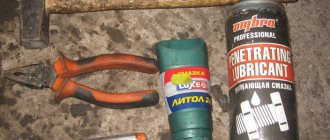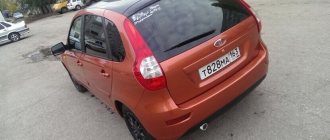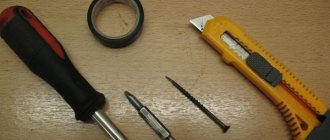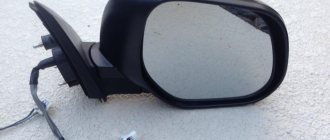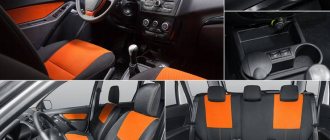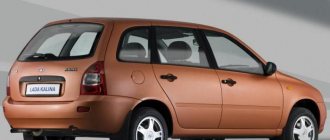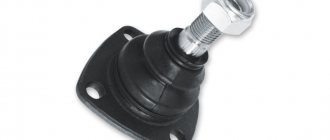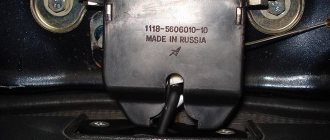To extend the life of the car body, you need to regularly monitor the condition of the drainage holes, otherwise rust may appear in the internal cavities. Also, do not forget to lubricate the rubbing parts of the body. Let's consider the features of such a service.
For LADA cars (XRAY, Vesta, Largus, Granta, Kalina, Priora, Lada 4×4) there are no fundamental differences in cleaning the drainage holes and lubrication of body fittings.
Lada Kalina Universal Lux (Belka) › Logbook › Water under the driver’s mat
A week ago I noticed that the carpet under the driver's mat was wet at the location of the driver's heel. It became especially noticeable how it froze (we have -9), a white spot formed from frozen water crystals. One good thing is that it’s not antifreeze, it wouldn’t freeze. I surfed the Internet. There are several reasons for water getting under the mat: 1. Absence or loose fit of body plugs on the bottom (new plugs were all installed), 2. Leakage through the wiring harness from the engine compartment (haven’t climbed yet, you need to remove the fender liner), 3. Poor quality weld in the drain area on the driver's side, 4. Poor quality gluing of the windshield in the lower left corner, 5. Through the loose flap of the driver's door, 6. Through the door cutout for the speakers in the driver's door (hard to believe, but some Kalinas have had this happen). check all possible leaks. I'm looking forward to the weekend. If only the weather would allow it. There is no garage. It will be possible to completely dry the Shumka only in warm weather; you will probably have to disassemble the interior. I would be grateful for your informative comments.
Likes 16 Shares: Subscribe to car
www.drive2.ru
Kalina rear shock absorbers squeak
How soon should this thing die?
Yes. Moreover, this kind of garbage with SAAZs has been going on for about 15 years now (maybe it happened before, too, but I don’t know): “normal” ones go to the assembly line (in the sense that the characteristics are disgusting), but the spare parts are defective. And it seems to me that everyone knows about such garbage.
Added after 3 minutes 58 seconds:
To be honest, I don’t want to believe it, because I installed the current last day, and it creaked immediately when I took the first turn. It's really already dead and I'm driving on the left shock absorber, how can I check without removing it?
Now everyone seems to know for sure
, I was the last patriot I thought the original spare part in the original packaging was a guarantee of happiness, damn the factory ones rolled 100 thousand km off the assembly line, I wanted to drive another hundred thousand on the same ones
What other other parts can sound when the body sways in the shock absorber area, if it didn’t squeak before the replacement, please enlighten me, maybe it will pass? The creaking is perhaps more high-frequency than in the videos on YouTube about creaking shock absorbers, for example on a viburnum.
I thought the original spare part in the original packaging was a guarantee of happiness
Probably each of us has gone through this once.
.
The factory ones drove 100 thousand km off the assembly line, I wanted to drive another hundred thousand on the same ones
What other other parts can sound when the body sways in the shock absorber area, if it didn’t squeak before the replacement, please enlighten me, maybe it will pass?
Source
Water under the driver’s feet - logbook Lada Kalina Sedan 1.4 16V 2010 on DRIVE2
The hackneyed topic never ceases to be relevant. I’ll tell you how I looked for and eliminated water leaks into the cabin.
We got around to drying the sound insulation of the cabin, namely under the feet of the driver and the passenger behind him. This was facilitated by two conditions: summer vacation and good weather. I noticed back in the spring that when I pressed my hand on the floor, water leaked out and the driver's mat underneath was constantly wet. At first I thought that water was flowing from the bottom. I noticed two holes that did not have rubber plugs in them. I bought it, installed it, but it didn’t help. I started looking more closely and noticed that water was flowing from the inside along the wall, behind the fuse box, when it rained.
The area to look is highlighted. Rust on the pipe is also noticeable, but we’ll talk about that a little later. By the way, the water flow through the pipe dripped directly onto the relay terminals, which is very bad. But there were no consequences for me.
water trickled out in a thin stream during moderate to heavy rain
With the help of a second person and a hose with good water pressure, they found the leak. Although I initially blamed the bad windshield sealing - it was changed by the previous owner. I even applied silicone along the entire side edge and bottom (as it turned out, it was not in vain that I thought so). To work, I removed the wipers and the plastic covers under them. It turned out that this was a place near the loop. The photo below shows the place, but I don’t know what it’s called (those who know, write in the comments).
watering this particular place, water flowed inside, a little to the left, a little to the right - the flow disappeared
Also suspicious was the weld just below
Next, dismantling the interior, lifting the carpet and drying it in the sun. I dried it in the sun and in a warm, dry attic for two days.
I covered the found “gap” with transparent silicone sealant. Everything that was nearby too. The picture we got was something like this.
I waited for it to dry and tested it with a hose. Everything is dry. While the interior was disassembled and the Shumka was drying, I decided to slightly glue the bottom from the remains of vibroplast and splen. Although this is a dead poultice, it somehow managed to compensate for the lost qualities of the standard sound insulation.
Below is vibroplast, above is splen
There is only splen here - the vibration is over
Came home after drying and assembling. In the evening there was a heavy downpour. Upon completion, I went to check the quality of the work and was surprised - there was water on the mat and smudges in the area of the fuses, even on the inside of the lid, water had collected. I began to follow the fresh tracks to see where the trail of water led.
red - water splashes
let's go higher...
After a little dismantling of the interior, I came to the top of the windshield, just to the left of the middle. It just started raining again and I started looking at where the leak was coming from. The photo shows a place that was already sealed, but the meaning is the same.
glass sizing turned out to be unimportant
The most interesting thing is that the water flowed in a thin stream along the roof sheathing, and exactly flowed into the door seal, through which it flowed down.
Such a design that the eye will not notice the leak. Everything is hidden and flows neatly down.
The next logical step was to seal the seam outside and inside with sealant.
The first sizing was done with a different sealant - this one had higher temperature indicators (according to the manufacturer - USA). This German seems to be the one who was at home.
Since then, no water has been noticed in the cabin, but time will tell. I hope my experience will be useful to someone. I look forward to reviews, comments, criticism.
PS I read a lot that in Kalina water under the driver’s feet is due to a clogged drain hole under the wiper motor. I didn’t see such a problem myself.
www.drive2.ru
Suspension arms or beam - check fastenings and silent blocks
One of the common causes of knocking in the rear suspension is the beam. If your car has such a suspension design, it is worth determining the exact location of the knock. To do this, you need to put the car in a pit, ask someone to rock the car, and in the pit, grab hold of various places on the beam with your hand. Most often we are talking about the knocking of the silent blocks of the rear beam. The suspension arms may also knock, and here the diagnosis will be somewhat more complicated:
- you need to install the car in the pit, putting it on speed, and not on the handbrake, then climb into the pit, taking with you a pry bar, a large screwdriver, and a set of keys;
- using a mount, check the functionality of the bushings and silent blocks; if they move easily in their seats and noticeably play, they need to be replaced;
- check the integrity of the suspension arms, their bending can lead to knocking and uneven running of the car, and cracks indicate the need for quick replacement;
- the fastenings of the levers can be loose, for this you need to use keys and tighten all visible connections, this will help eliminate this item from the causes;
- When the suspension elements are deformed, the levers themselves can knock on body parts and other elements of the rear suspension space while driving, so you can rock the car and find out.
A fairly simple diagnosis of the rear suspension by rocking the car helps to obtain information about the condition of your car very simply and without any problems. However, it is not always possible to actually obtain data on the state of the suspension, since vehicles do not always reveal all the secrets from simple rocking. It may well be that there is a knock on the road, but there is none at the service station. So another diagnosis may be required.
Lada Kalina Sedan Atom1c › Logbook › Fixing leaks under the driver’s feet
Hi all. Some owners of viburnums have probably encountered such a problem as water in the cabin under the driver’s feet. I decided to share my method of eliminating this problem. This problem happened to me after installing the on-board vehicle. To splice the wire from the BC with the FLS wire, it was necessary to find a block behind the mounting block with the required wire. The problem was that the wires in the harness were tightly grouped and in order to splice the necessary ones, I had to slightly pull the harness towards myself. Apparently, after this manipulation, the rubber seal through which the harness passed into the cabin burst. The rubber band can also be torn when installing an alarm. After this, I began to notice that either after washing the car, or after rain, under the driver’s mat the carpet became like a sponge (if you pressed, water came out). It works like this: the water flowing down the windshield disappears through drainage holes in three places. One on the right under the cabin filter, the second in the middle, the third on the left. Under the hole on the left, in the wing, there is the same wiring harness through which water from the hole in a thin stream enters the cabin through a torn rubber seal.
This is approximately where the wiring harness and rubber seal are located.
You can check by pouring a little water from a bottle into the hole and lifting up the carpet and sound insulation on the driver's side, watching how a trickle of water oozes through the wires in the corner. After reading the Kalina Club forum, I found similar problems that were sometimes eliminated by generously covering the sealing gum with sealant. This procedure helped, but not for long. I decided to act radically I took a hose along the diameter of the hole, 30 cm long, and inserted a cut neck from a bottle for transmission oil into it (it turned out like a funnel, but with a flat head).
I installed this device and again checked for leaks. Water no longer seeped into the interior. PS: There have been good rains recently, everything is dry under the carpet 
Issue price: 0 ₽
Likes 23 Shares: Subscribe to car
www.drive2.ru
Kalina rear shock absorbers squeak
at the same time, you can also pump up the ammo, if this wasn’t done at the service,
well, not just compress it, decompress it, but using technology. On Kayaba’s website https://www.kybcom.ru/prokachka.html there is, for example.
Technology for pumping McPherson struts and cartridges:
A. Install the stand or cartridge with the rod up and smoothly, without jerking, compress it to a certain point (the working surface of the rod should not reach the top of the stand glass by 2-3 cm);
B. Fix the shock absorber rod in this position for 2-3 seconds;
B. Smoothly pull the rod until it is fully extended;
D. Repeat operations A, B, C 2-3 times;
D. Holding the shock absorber vertically, with the rod up, perform a control operation (with sharp but short movements of the rod, make sure that the piston moves smoothly, without failures). In well-pumped shock absorbers, the piston moves smoothly without dips (please note that in some shock absorbers, when fully decompressed, the valve mechanism may enter the compensation cavity, designed to expand the shock-absorbing fluid when warmed up, and not provide any resistance).
Technology for pumping all other shock absorbers:
A. Turn the shock absorber over with the rod down and compress it smoothly, without jerking;
B. Fix the shock absorber rod in this position for 2-3 seconds;
B. While holding the rod, turn the shock absorber over with the rod up, fix the shock absorber in this position for 3-6 seconds;
D. After keeping the shock absorber in a vertical position for the specified time, smoothly extend the rod to the end of the stroke;
D. Turn the shock absorber over with the rod down, pause for 2-3 seconds. and repeat operations A, B, C, D 2-3 times;
E. Having finished pumping the shock absorber, following the sequence, stop at point D;
G. Holding the shock absorber vertically, with the rod up, perform a control operation (with sharp but short movements of the rod, make sure that the piston moves smoothly, without failures). In well-pumped shock absorbers, the piston moves smoothly without dips (please note that in some shock absorbers, when fully decompressed, the valve mechanism may enter the compensation cavity, designed to expand the shock-absorbing fluid when warmed up, and not provide any resistance).
After pumping, the shock absorber should be in the working position, WITH THE ROD VERTICALLY UP, until it is completely installed on the vehicle.
Source
VERDICT
Oleg PETRIKOV, “Behind the Wheel” test driver, Russian vice-champion
06
I really liked the Proma kit for its deceleration efficiency. With it, in addition, the clarity of the drive has improved - it’s easier for me to control the deceleration with pedal effort, although I admit that this will cause some difficulties for ordinary drivers. I think most motorists will like the HP Brakes kit, which is similar to “civilian” brakes in terms of pedal movement and force on it.
In each case, Kalina does not become much faster on the race track, and it was not possible to assess which set will last longer - even after fifteen laps in racing mode, the front brakes do not lose effectiveness.
In everyday use of the Lada, standard mechanisms are quite sufficient. It makes sense for residents of regions who operate their cars on mountain roads to install more efficient ones.
Check the mileage of the VAZ2114 electronic speedometer yourself
Since 2001, several options for combinations of electronic devices have been installed here:
- AP panel (manufactured by Vladimirsky, equipped with a PIC12C519 microchip). There have been cases of failure of this chip. The cause is a manufacturing defect. You can reinstall and flash it using the PO-5 programmer. The cost of making adjustments in workshops is 1100 rubles.
- Electronic system Shetmasch. For working with her in services they will ask for 1600 rubles.
- Electronic device type VDO. The master will ask for 1500 rubles for his work.
To do the work yourself, you will need knowledge of electronics and appropriate equipment (a computer with the program installed). A connection is made to the car’s electronics, and the kilometers are manipulated.
Here are general concepts and an algorithm of actions. It is absolutely clear that not every technology lover will understand it. It takes some time to learn the basics of electronics. For those who are concerned about the question of how to connect the speedometer and mileage of a car, steps for disassembling and connecting the equipment are given.
Installation of brake pads and discs from a foreign car
Instead of original VAZ brake pads and brake discs, install consumables from a foreign car, for example:
- Brembo brake discs (article: 09.8903.75) or ATE Power Disc 14 (article: 24.0320-0142.1);
- pads from Fiat (article: 13.0460-2813.2) or BMW (article: 180281).
No modifications or design changes to the brake system are required. The maximum that may be required (for example, for pads from BMW) is to slightly file the caliper brackets.
How to detect the unwinding of kilometers?
Determining interference has a low chance, but motorists should know what the interior elements look like at a specific mileage. The driver and front passenger seats may be too dented, the handles may be worn, and will have scuff marks that do not match the advertised mileage readings. But the owners can also slightly patch up the interior. Covering the seats and replacing the handles is not a very expensive procedure.
We dealt a little with the question of how to adjust mileage on an electronic speedometer, the situation became clearer and general concepts became known. When choosing a used vehicle, you need to pay more attention to its condition; drivers take care of their equipment differently.
Let's sum it up
There are many interesting options for car repair. Among them there is also self-diagnosis. This is a great advantage for every owner that you can do your own research on the car, detect problems, and go to the service already prepared for all the nuances. Our modern service stations do not always tell the truth about problems, make incorrect diagnoses and make money out of the blue. This is why there is an outflow of customers to garage foremen. Sometimes the latter offer much better quality of services.
There are indeed many complex elements in the rear suspension, and sometimes it is very difficult to diagnose. But in fact, you just need to gain a little experience in order to more or less understand the details of the chassis. This will help you simply carry out the necessary actions and get a more or less good inspection of the car yourself. If you have a master whom you completely trust, it is better to contact such a specialist. This will help you find the cause much faster and perform high-quality repairs in a matter of hours. How do you prefer to detect the causes of knocking noises in your car's suspension?
It often happens that, especially when braking a car, a strange knocking or creaking noise is heard from behind. This is most likely a knock in the rear suspension of the car. In order to determine the cause of a knock in the rear suspension, you should familiarize yourself with the main components of the rear suspension and diagnose them.
Tip #4
The strange-sounding engine of the Kalina 1.6 8kl, the design and photo of which can be found on the Internet, is sometimes caused by the fact that its drive disk is covered with a damping rubber gasket. When rubbing against the belt, it becomes charged with static and begins to negatively affect the crankshaft position sensor. If the car is parked for some time, the gasket will lose charge and the sensor will begin to function normally. You can correct the situation with a little trick: screw two small screws into the disk and connect them with stranded wire. This device is covered with fiberglass putty to prevent rust.
Tip #7
If you carefully watch the video, which shows the operation of the 8-valve engine from the inside (the timing cover is removed), you will notice that strange sound effects appear at the moments when the camshaft gear begins to vibrate, causing it to lose its sharpness in the video. From what we saw we can conclude that there is a slight play between the 1st camshaft journal and its seat. The reason for its appearance may be inaccuracy in the design of these elements.

